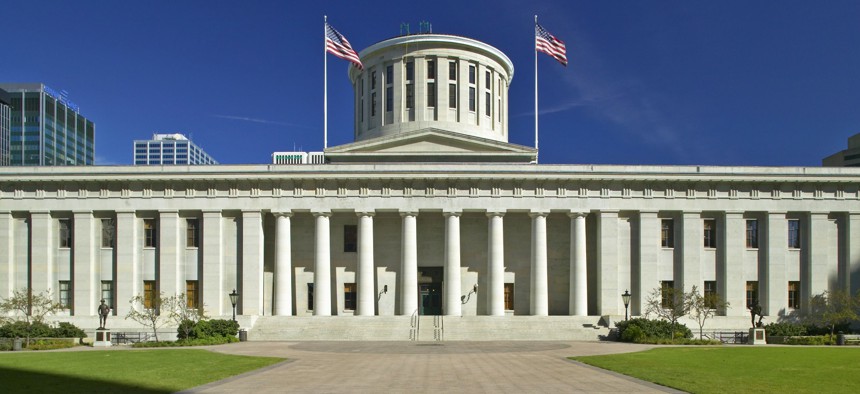Banning Down Syndrome Abortions in Ohio; Major Marine Life Die-Off in Alaska

The Ohio State Capitol in Columbus. Joseph Sohm / Shutterstock.com

Connecting state and local government leaders
Also: New Orleans still reeling from Katrina and East Austin residents push back against gentrifiers.
Here’s some of what we’ve been reading today …
CLEVELAND, Ohio: In a Sunday front-page story, The New York Times looked at a proposal likely to become law this fall in the Buckeye State that would ban the abortion of fetuses with Down Syndrome. Ohio has led the nation in passing a variety of abortion restrictions over the last five years but, so far, pro-life Gov. John Kasich, who is running for the Republican presidential nomination, has yet to take an official stand on the proposal. Opponents say the bill is just another step in the national drive to chip away at abortion rights. They say the proposed law would be unenforceable.
“If abortion on demand is legal, and you can have an abortion just because you want to, what does it mean to say you can’t abort for Down syndrome? It seems bizarre,” Dr. Marjorie Greenfield, a professor of obstetrics and gynecology at Case Western Reserve University School of Medicine, told The Times. [The New York Times]
KODIAK, Alaska: What’s happening to marine life in Alaska? The Guardian reports that since the beginning of May, “eleven fin whales, fourteen humpbacks, one gray whale and four unidentified cetaceans have stranded on islands of the western gulf of Alaska and along the peninsula’s southern shore. Most died in the Kodiak archipelago.” Scientists from the National Oceanic and Atmospheric Administration studying the strandings are “very concerned” but so far have no answers. “Our leading theory is that a harmful algal bloom has contributed to the deaths,” NOAA spokesperson Julie Speegle told The Guardian.
Also, the Alaska Dispatch News reports on the financial blow dealt to a major effort to learn why King Salmon stocks in the state have declined over the last decade. The $30 million Chinook Salmon Research Initiative launched in 2013 has been slashed by lawmakers. The five-year effort saw 100 researchers take up three-dozen projects across twelve major river systems. They’re now set to focus on only about a dozen of those projects. “We’re hopeful that another appropriation will come down the pike,” Ed Jones, a coordinator with the state Sport Fish Division, told the paper. “These are long-term endeavors. We’ve just scratched the surface.” [The Guardian, Alaska Dispatch News]
NEW ORLEANS, Louisiana: Moody’s Investor Service reports on the state of Crescent City finances a decade after it was hit by Hurricane Katrina, the mammoth storm that rolled over the region Aug. 29, 2005, killing nearly 2,000 people, laying waste to flood-control infrastructure and, in the end, wracking up some $100 billion worth of damage. Moody’s lauds the city’s recovery efforts but notes it is still clawing back to pre-hurricane economic health levels. According to Reuters:
Pension, retiree healthcare and debt service costs combined increased nearly 54 percent from 2009 to 2014, from $129 million to $198 million in 2014, Moody's noted, while fixed costs exceeded 30 percent of the city's operating revenues, even as its contribution to its public pensions fell $17.7 million short in fiscal 2014.
Moody’s analysts say the city is still too dependent on the volatile oil-and-gas sector and that its population still falls 18 percent short of levels reached before the storm. [Reuters]
AUSTIN, Texas: The La Loteria mural graced the side of a building in East Austin for 25 years before it was covered over by South-by-Southwest music festival promoters in 2015. Community members were not happy. “With a lot of the stuff happening in East Austin—folks being moved out, property taxes getting too high—it was like, you know, something’s got to change,” artist Filipe Garza tells the Austin American-Statesman. “People aren’t respecting who we are and what we represent.” The mural referenced a Mexican card game and featured social and political commentary on issues like national-immigration and city-development policies. The community rallied to have a team of artists redo the original. “We don’t have a lot of property. But we have talents and our heritage,” says Garza in an interview for a video-story about the mural. [Austin American-Statesman]
DENVER, Colorado: Civic leaders in Colorado are determined to do something about the tangle of constitutional amendments and referenda that have grown up around the state budget over the last few decades, constraining the legislature in its ability to raise and allocate resources, hobbling infrastructure and education spending and now routinely giving rise to lawsuits. As The Denver Post reports, a bipartisan group of policy wonks and current and former state officeholders will undertake a 40-stop statewide tour this fall to discuss the state’s election system, wide-open constitutional amendment process and the loved and hated Taxpayer's Bill of Rights. The group has dubbed the effort “Building a Better Colorado.” This won’t be the first time frustrated state leaders have attempted public outreach to help untie the Gordian knot wrapped around the state budget, but this latest effort seems like something new. As The Post puts it: “This project is perhaps the most concerted effort yet to address what organizers see as inherent conflicts in how the state is governed.” [The Denver Post]
John Tomasic is a journalist based in Boulder, Colorado.

NEXT STORY: Gov. Brown: California Might Be Headed Toward ‘New Normal’ With Wildfires Due to Climate Change




